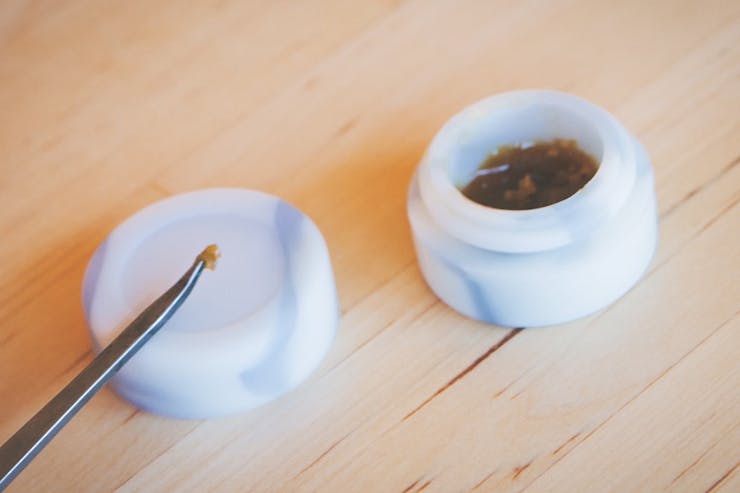Once upon a time, buying cannabis oils for dabbing came down to choosing from a small selection, but today’s display cases are often loaded with dabs of all varieties as shops cater to increasing demand. If you’re new to dabbing, your head is probably spinning with questions about extract types, costs, and so on.
Glossary of dabbing terms
Having a grasp on some commonly used dabbing terms will go a long way as you deliberate over the glass dabbing case at your local dispensary or rec shop. This list of jargon may look long, but don’t worry – a lot of these are just different names for the same thing.
Budder – Refers to extracts that take on a creamy, butter-like consistency.
Butane Hash Oil (BHO) – The most commonly used extract for dabbing, BHO uses butane to strip essential compounds like THC, CBD, and terpenes from the cannabis plant, concentrating them in an oil of varying consistencies (see also: shatter, wax, budder, crumble, pull-and-snap).
Concentrate – Broadly refers to any cannabis product that concentrates cannabis compounds from raw plant material.
CO2 Oil – A type of cannabis oil that uses pressure and CO2 to extract essential compounds like THC, CBD, and terpenes from the plant. This oil tends to be soft or runny, and often takes on an amber hue.
Crumble – Refers to extracts that take on a soft, crumbly texture.
Dab(bing) –“Dabbing” refers to the method of flash vaporization in which oils are applied to a hot surface and inhaled (see also: dab rig, nail). “Dabs” can refer to any extract used for dabbing.
Dab Rig – Also called an oil rig, a dab rig refers to a water pipe with dabbing attachments (see also: nail).
Honeycomb – Refers to extracts that take on a soft, honeycomb-like texture.
Shop highly rated dispensaries near you
Showing you dispensaries nearNail – A nail refers to the metal, glass, or ceramic spike attached to a water pipe. Dabs are applied to the nail once it’s been heated by a torch or electronically.
Oil – A broad term that refers to many different cannabis concentrates. It implies a runny, oil-like consistency, but cannabis oil has become a ubiquitous term that describes extracts of many forms and consistencies.
Pull-and-Snap – Refers to extracts that take on a taffy-like consistency that may “snap” when bent.
Purge – Refers to the process of removing solvents during extraction. (Note: high levels of residual solvents can be unsafe for consumption, so make sure the product you’re purchasing has been lab tested).
Rosin – A solvent-less extract that uses heat and pressure to concentrate essential cannabis compounds.
Shatter – Refers to extracts that take on a transparent glass-like consistency.
Solvent – A solvent refers to the chemical compounds (e.g. butane, alcohol, propane, etc.) that strip cannabinoids and terpenes from plants. Some concentrates (e.g. rosin, ice hash) can be produced through heat, pressure, and water — these are called “solventless” extracts.
Wax – Refers to extracts that take on a soft, waxy consistency.
Dabbing FAQs
Have a question about dabbing? Check out these frequently asked questions!
What equipment do I need to dab?
Before you buy dabs, you’ll want to make sure you have everything you need to deliver one. Traditional dabbing setups include a water pipe, a nail, a dome, and a torch. Check out this article for more information on the equipment you’ll need to get started.
How does the price of extracts compare to the price of flower?
A gram of flower costs a lot less than a gram of oil, but keep in mind the difference in potencies: while bud tends to test between 10-25% THC, a concentrate can reach heights of 50-90%. The initial investment will be steeper, but keep in mind that a little bit goes a long way with dabs. Concentrates can be more cost-effective than flower, but it all depends on the product’s potency-to-price ratio.
Because flower and oil prices can vary significantly in different markets and across different brands, it’s always best to check your local dispensary’s menu. For example, I’ve bought a half gram of BHO in Seattle for as little as $25 and as much as $70 for high-potency oils; it all depends on the brand, potency, and regional market.
How long will a gram of oil last me?
This is another question that has to be answered with, “it depends.” A half gram of oil can tide the occasional dabber over for a couple weeks, whereas a heavy, high-tolerance consumer might blow through that much in a day or two. Depending on the size and potency of your oil, a half gram can typically provide up to 20 dabs.
How do I determine an extracts purity and potency?
Extract quality is determined by multiple factors, many of which cannot be determined by the eye. Light, gold-colored oils is often a mark of quality, but contrary to popular misconception, texture and consistency don’t signify purity or potency. The most important thing in determining oil quality is lab testing; there’s no other surefire way of measuring residual solvents, contaminants, or cannabinoid content.
What’s the difference between shatter, honeycomb, crumble, and wax?
When talking about BHO, there isn’t a lot of difference between shatter, wax, crumble, honeycomb, budder, etc. beyond their consistency and texture.
An oil’s consistency is essentially determined by the amount of moisture the oil held onto and molecular disturbance. In other words, if an oil is agitated during the extraction process, it may lose its transparency and become a softer, waxier texture. Some strains also have a tendency to “sugar up” when processed into extracts due to their lipid contents. Changes in temperature, humidity, and oxygen exposure may also affect the texture. Some dabbers actually prefer the sugary oils because they often taste better due to terpene preservation – but beyond that, you don’t need to place too much importance on consistency.
How do I store dabs?
Although most dabs are purchased in plastic containers, dabbers typically prefer to store their product in silicone dab containers afterwards. Dabs won’t stick to silicone, so it’s a great way to both prevent wasting oil and keep your container free of annoying stickiness.
What kinds of oils are safe to dab?
Your local dispensary or rec shop might have a number of cannabis extracts on the shelf, but keep in mind that not all are meant for dabbing. For example, alcohol-based extracts like RSO, ISO wax, and tinctures are meant for oral ingestion and should never be smoked or dabbed. When in doubt, check with your budtender to see if an oil is safe for dabbing.
Will all dabs get me high?
A lot of people avoid dabbing because cannabis extracts have a reputation of getting you pretty ripped. For sure, most dabs are made to contain high levels of THC – but you may not be aware that some extract producers use high-CBD, low-THC strains to create oils with little to no psychoactive effects. One of my favorite oils right now is an ACDC wax that induces almost no cerebral euphoria – just a hefty dose of relief for pain and muscle tension. A product like this is ideal for the patient who needs a potent and fast-acting medicine without getting totally donked.
Can dabs be medicinal?
Absolutely. Patients needing a swift dose of THC to ease nausea, stress, appetite loss, pain, insomnia, and other symptoms may actually find dabbing to be an efficient way to deliver relief. As mentioned above, there are also high-CBD dabs with a myriad of other therapeutic benefits. Clean, pure concentrates are also commonly preferred by health-conscious consumers because they strip out resin-producing plant material.
This post was originally published on December 16, 2015. It was most recently updated on June 26, 2020.





